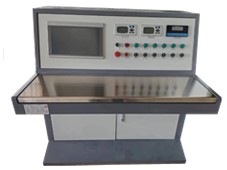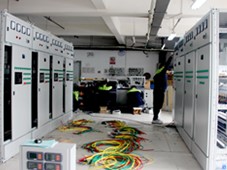-

-
 Tel:86-13526433367 / 86-0371-56520104
Tel:86-13526433367 / 86-0371-56520104 -
 Email:info@hnrentai.com
Email:info@hnrentai.com -


CONTACT
- Tel:86-13526433367 / 86-0371-56520104
- Fax:86-0371-56520103
- Email:info@hnrentai.com
- ADD:Building 12, Electronic and Electrical Industry Park, Zhengzhou, China
- OFFICE ADD:Block 7, Yida Technology Industrial Park, Zhengzhou, China
Current location:HomeAbout RentaiRentai BlogRentai Blog
How to Achieve Remote Centralized Control and Cloud Data Integration in Heat Exchange Station Upgrades
In the field of centralized heating, achieving remote centralized monitoring of heat exchange stations and integrating operational data to the cloud has become a key trend in the development of smart heating. Under traditional heating management models, heat exchange stations often rely on manual inspections, with data scattered and lacking real-time capabilities, making it difficult to optimize operations in response to load changes. Through IoT and cloud platform technologies, connecting key parameters of heat exchange stations to a centralized monitoring system can not only reduce labor costs but also improve heating efficiency and safety. Henan Rentai explores the methods and practices for achieving remote centralized control and cloud data integration in heat exchange station upgrades.
Pathways to Achieve Remote Centralized Control
Establishing a Communication Network between Heat Exchange Stations and the Dispatch Center:
To enable remote centralized control, the first step is to establish data communication between the heat exchange stations and the central control center. Common solutions include installing data acquisition and communication devices at the heat exchange stations, connecting on-site equipment to the control center via wired or wireless networks. Specifically, industrial Ethernet, dedicated optical fiber networks, or cellular networks (4G/5G) are commonly used as communication mediums to transmit real-time data collected by PLC controllers and sensors to the monitoring center.
For example, some heating projects use water conservancy IoT cloud platforms integrated with 4G/WiFi networks to transmit the operating status of circulation pumps, makeup pumps, electric valves, and other equipment to the cloud for centralized monitoring. In Henan Rentai's heat exchange station control systems, RS485 buses and Ethernet interfaces are provided for local networking, and built-in GPRS wireless communication modules enable remote data transmission and command reception through IoT technology, achieving true intelligent centralized management. This communication infrastructure allows the dispatch center to monitor each station 24/7 and remotely intervene when anomalies occur, preventing escalation of incidents.
Centralized Monitoring Platforms and SCADA Systems:
Once the data communication foundation is established, the heating company’s dispatch center needs to deploy a centralized monitoring platform (such as a SCADA system or IoT cloud platform) to manage multiple heat exchange stations uniformly. This platform typically offers real-time monitoring, historical data storage and analysis, alarm management, and remote control functions.
Through the monitoring platform, operators can visually monitor parameters like the primary/secondary network temperatures, pressures, flow rates, pump, and valve statuses on a large display, and remotely issue control commands as needed, such as adjusting valve openings or starting/stopping pumps. Henan Rentai’s SCADA data acquisition and monitoring system integrates seamlessly with PLC systems, consolidating data from various stations into a unified interface, making it convenient for operators to manage centrally. With centralized monitoring, heating companies can dispatch heating load across stations based on the overall network demands, optimizing distribution and achieving more balanced and economical heating.
Switching between Remote and Local Control Modes:
While enabling remote control, it is equally important to retain on-site local control and safety interlocks. Typically, centralized control systems support three modes: remote automatic control, remote manual control, and local manual control. In remote automatic mode, the cloud platform adjusts equipment based on pre-set strategies (e.g., outdoor temperature and supply water temperature curves). Remote manual mode allows operators at the control center to directly command on-site equipment, while local manual mode enables on-site personnel to take control in case of communication failures or emergencies.
This multi-mode control mechanism ensures flexibility and safety. For example, if a station experiences communication failures or specific conditions that cannot be addressed by the program, it can be switched to local control until the issue is resolved. This setup ensures that centralized control does not compromise heating continuity due to remote system failures.
Cloud Data Integration and Intelligent Operations & Maintenance (O&M)
Real-Time Data Collection and Cloud Storage:
Cloud integration of heat exchange station data leverages the cloud’s robust storage and computing capabilities for big data analysis and intelligent O&M. The approach involves installing data collectors or gateways at each station to extract operational data from PLC controllers, which are then uploaded to the cloud via 4G SIM cards or campus WiFi networks. The cloud platform aggregates data from all stations into a comprehensive historical database.
For instance, some IoT solutions capture pressure, temperature, liquid level, and flow data from the heating network, along with the operating status of pumps and valves, and compile these into historical trends on the management cloud platform. Similarly, Henan Rentai's boiler IoT platform connects to PLCs via adapters, uploads data to cloud servers, and allows users to view real-time operating status, historical data, and fault information on their mobile phones or computers.
Big Data Analysis and Intelligent Regulation:
The true value of cloud data lies in leveraging cloud computing to analyze large volumes of operational data, enabling heating optimization and predictive maintenance. The cloud platform can statistically analyze historical data, plot temperature, flow, and pressure trends, and determine heat load patterns under different climatic conditions. Heating companies can then optimize control strategies, such as adjusting climate compensation curve parameters or optimizing pump scheduling to reduce energy waste.
Advanced systems incorporate edge computing and AI algorithms to analyze heating demand in real-time, combining time-specific, regional outdoor temperatures with historical usage data to predict future heat load requirements and preemptively adjust the heat source output and station allocations accordingly. For example, through edge computing, some solutions precisely control heating distribution by automatically adjusting valves and pumps based on calculated demand.
Moreover, cloud platforms can detect anomalies in real-time data using algorithms. Henan Rentai’s IoT system automatically analyzes cloud data to identify inefficiencies or potential faults and issues preemptive warnings before problems escalate. For instance, if a station’s secondary network outlet temperature significantly deviates from the set point for an extended period, the system alerts for potential sensor inaccuracies or valve malfunctions, recommending inspections. This smart diagnostics and expert suggestion feature assists maintenance teams in taking proactive measures to prevent failures.
Alarm Linkage and Maintenance Response:
Cloud-based data also enhances intelligent and efficient alarm management. When the platform detects equipment faults or parameter deviations (e.g., excessive network pressure or pump failures), it triggers alarm linkages based on pre-set rules. Common alarm methods include on-screen pop-ups on monitoring dashboards, push notifications to maintenance staff’s phones (via WeChat or SMS), and activating on-site audible and visual alarms.
For example, if a makeup pump fails at a heat exchange station, the cloud platform immediately notifies the duty personnel and triggers the backup pump to maintain system pressure. These responses can be fully automated under unmanned operations, enhancing heating system safety. Additionally, the cloud platform can auto-generate work orders based on alarm categories and assign them to nearby maintenance personnel, providing fault-related data and potential cause analyses to expedite response times.
Multi-Site Centralized Management and Access Control:
Remote centralized monitoring enables a dispatch center or maintenance team to manage multiple heat exchange stations simultaneously, significantly improving staffing efficiency. Traditionally, each station required dedicated inspectors, but with a centralized control platform, a single operator can monitor dozens of stations from a computer screen and remotely adjust settings or coordinate repairs when anomalies occur, reducing labor requirements.
Project experiences show that introducing remote monitoring can enable one person to oversee multiple stations, reducing inspection and maintenance costs and enhancing economic benefits. For operational security and role delineation, the system also offers user access controls, assigning different permissions based on roles—for example, managers can access and control all stations, maintenance staff are limited to their zones, and some accounts can be read-only for leadership insights. This ensures collaborative operations while preventing unauthorized actions.
Henan Rentai's Technical Expertise and Service Advantages
Achieving remote centralized control and cloud data integration in heat exchange station upgrades involves the integration of IoT, automation control, and cloud computing technologies. Selecting the right professional partner is critical. Henan Rentai Electrical Equipment Co., Ltd. possesses mature solutions and extensive experience in boiler and heat exchange station IoT applications.
Rentai’s boiler IoT system interfaces with PLC/DCS controllers via data collectors, transmitting operational data to the cloud in real-time over 4G/5G networks. Users can view site conditions and remotely adjust equipment from mobile phones or computers. The cloud platform provides comprehensive functions including remote monitoring, historical data analysis, and proactive fault alarms, enabling customers to achieve intelligent centralized management of heat exchange stations.
In terms of implementation services, Henan Rentai offers end-to-end solutions—from on-site communication network architecture design and equipment installation and commissioning to cloud platform deployment—tailored to customer requirements. The professional team provides 24/7 technical support and O&M services to ensure stable and optimized system operation post-deployment.
By partnering with Henan Rentai, heating companies, system integrators, and end-users can more efficiently and securely realize remote centralized control and cloud data integration of heat exchange stations, advancing towards a new era of smart heating.
For more information, please contact Henan Rentai Electric:
Phone: 17638563962 / 0371-56520104
Email: info@hnrentai.com


